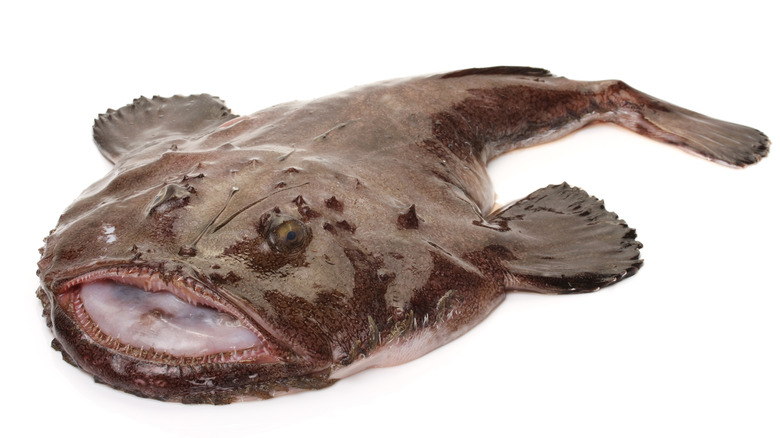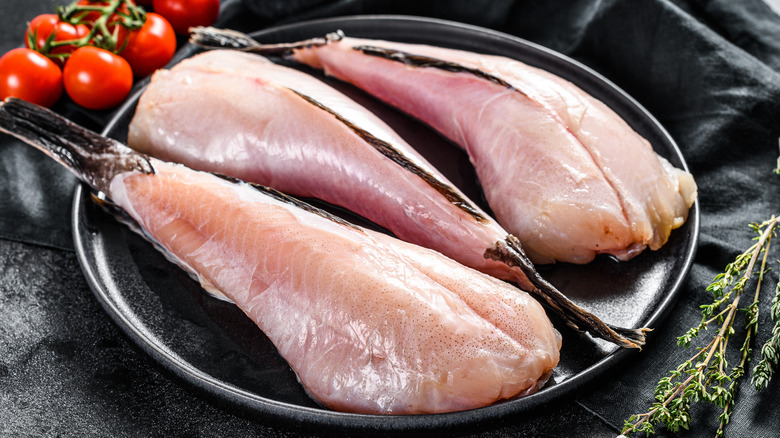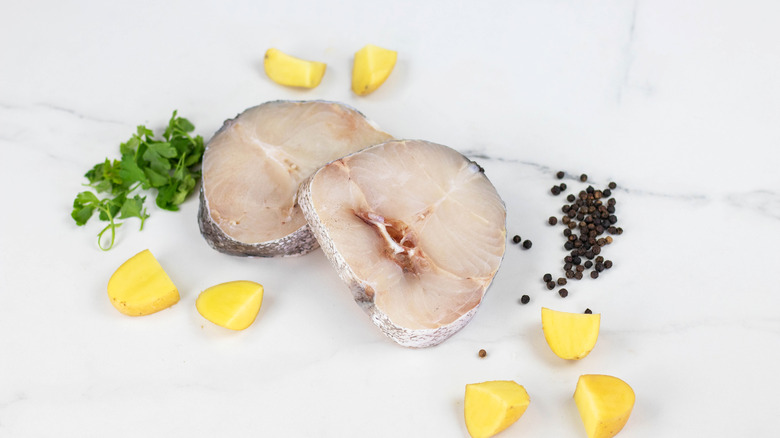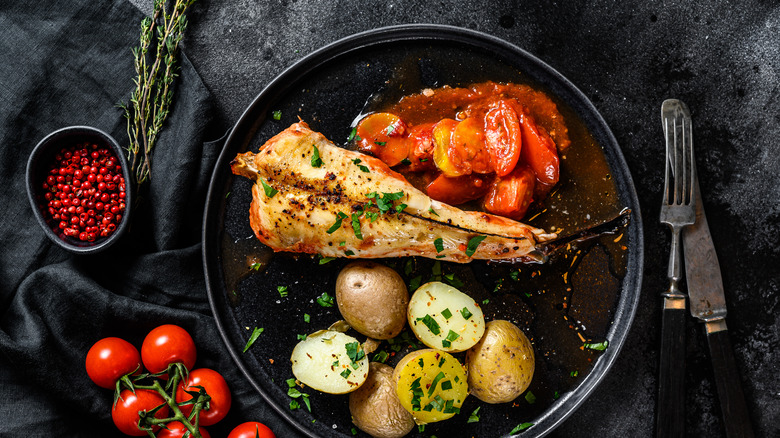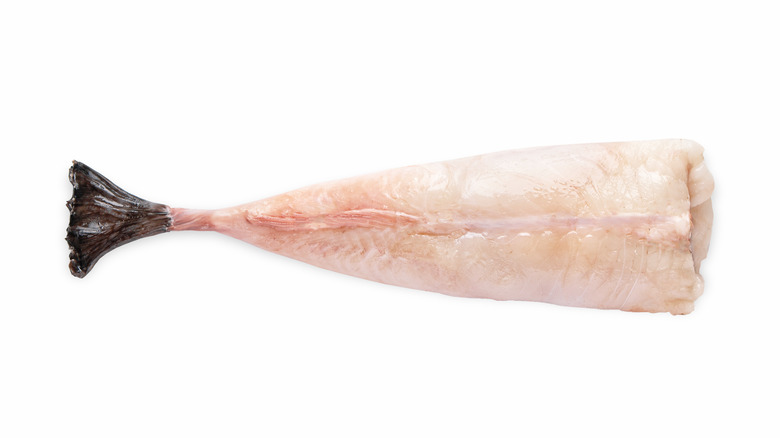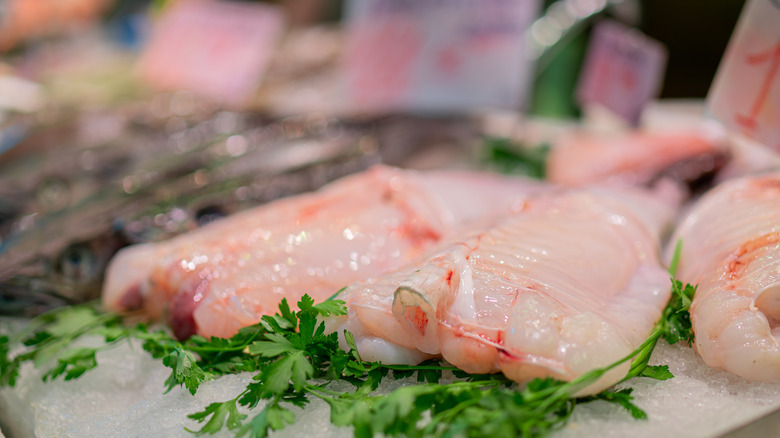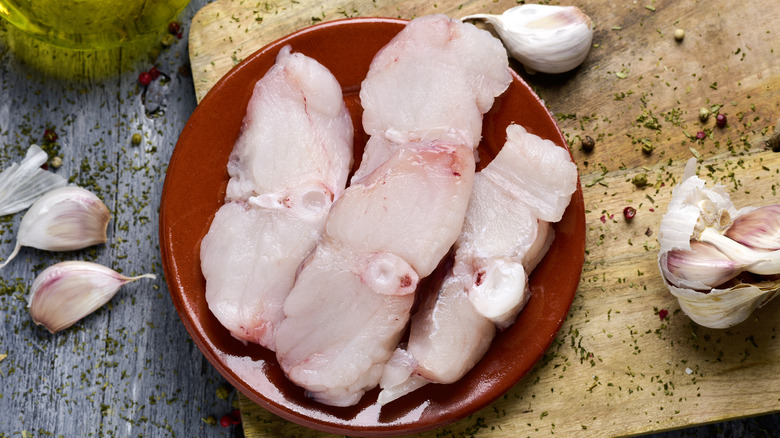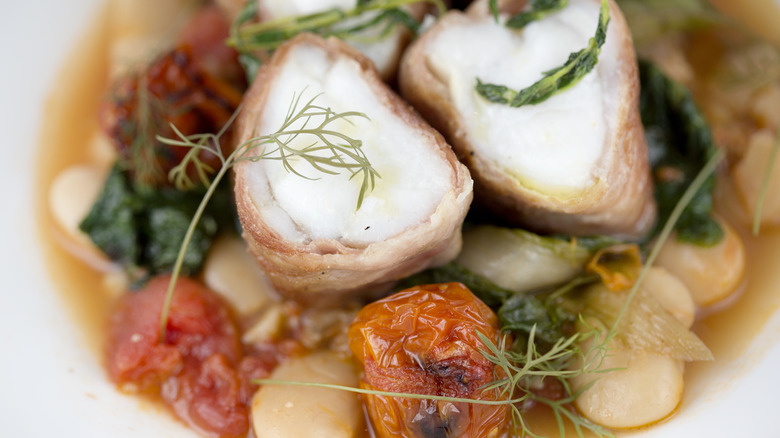What Is Monkfish And How Do You Cook With It?
Monkfish (Lophius americanus) certainly isn't the prettiest fish in the sea. Occasionally referred to as a "sea devil," it boasts a massive head that takes up about half of its body, complete with a gaping mouth displaying two rows of sharp, needle-like teeth. But don't be deterred by that unseemly appearance. Also known as the "tenderloin of the sea" or "poor man's lobster," Monkfish more than earns its other, more savory nicknames. It's a delicious fish with toothsome flesh and a sweet aroma. If you need even more convincing, the late, great Julia Child even called it "a cook's delight" thanks to its firm texture and versatility.
For everyone from the monkfish novice trying to get past its unseemly appearance to the aficionado looking to deepen their knowledge of the delicious groundfish, this guide is the perfect one-stop source. Learn to source and choose monkfish, store it properly, and serve it in recipes that will have your guests grinning from ear to ear!
What is monkfish?
Monkfish, a member of the anglerfish family, resides in the North Atlantic Ocean, from Canada to North Carolina, Norway down to the Mediterranean, and along the West African coast. Enjoyed throughout Europe (particularly in France, where it is known as lotte, a name occasionally borrowed into English), monkfish is also perceived as a delicacy in Japan, shares This Fish. Monkfish are prized for their snowy white tail meat, but the cheeks and liver can also be consumed.
Unlike many other white fish, monkfish boasts no small bones. As such, monkfish is easy to prepare, and many fishmongers sell it as ready-to-cook steaks or fillets. Wild-caught monkfish is a sustainable choice boasting healthy stocks. The massive heads are often recycled as lobster bait, which helps reduce food waste. The flesh is low in calories and rich in vitamins and minerals. Monkfish also played a role in the fight against diabetes, as the fish's pancreas was one of the first sources of manufactured insulin.
What does monkfish taste like?
Monkfish's nickname of "poor man's lobster" gives a hint as to its flavor and aroma: mild and sweet. It also has a lobster-y texture which is meatier than many other white fish. Some also compare its flavor to that of scallops, while Brandon Chavannes, executive chef at The Betty in Atlanta, suggests it tastes more like a grassier grouper. Whatever comparison you choose, the facts remain: Monkfish is relatively mild and thus marries well with a variety of other flavors, whether it's a simple squeeze of lemon or something more assertive, like curry.
While most commonly consumed as fillets or steaks, monkfish cheeks are also prized. (If you get a whole monkfish, you can remove them from just beneath the eyes.) They're preferred for being sweeter and more tender than the filets.
Monkfish liver is a delicacy that is especially beloved in Japan, where it is commonly served at sushi bars. Known as "ankimo" in Japanese, it's sweet and briny, with a melty texture. It can be served in place of foie gras on toast with a sweet accompaniment like chutney.
How to cook with monkfish
Monkfish can either be enjoyed raw or cured, as in a crudo, but is more commonly cooked. The firm, meaty fish stands up relatively well to direct heat methods such as grilling and roasting, and it won't fall apart when baked or stewed, unlike more delicate, flakier fish. Monkfish can even be stuffed and roasted as a pescatarian alternative to chicken or turkey. It's sturdy enough to be fried in the style of schnitzel or ground into a briny monkfish ragu to serve over pappardelle. Be careful not to overcook it, however, lest it grow tough.
The raw, off-white, or pale gray fillets may need to be peeled of their impressive seven layers of skin (which resemble a gray membrane) before cooking. While it doesn't have any of the small bones fish fans are used to handling, it does have one long backbone that can be removed before or after cooking, depending on the recipe. According to Chef Adam Evans of Automatic Seafood and Oysters, bone-in monkfish tends to cook more evenly.
Sauce-wise, the French love a tomato-based "Armoricaine" style monkfish stew, while Sicilians add briny capers, olives, and sweet raisins to complement the mild flavor of the fish.
How and where to buy monkfish
It's often said that when buying whole fish, it's important to pay attention to its eyes. That can be tricky for monkfish, which is often sold headless or, at the very least, upside down. Both are methods to keep consumers from fearing its dramatic appearance. Selling it upside-down is common in Italy, while removing its head is preferred in France. (Beyond the aesthetics, monkfish also tends to get the guillotine treatment because the head makes up 50% of the fish's weight, and fishermen often prefer to dump them overboard so they can make more space for the meat.)
In the U.S., you'll often find monkfish tails sold whole and peeled or even pre-cut into steaks or fillets that are ready to cook. The fillets should be off-white or pale gray when raw, and they may need to be peeled of their gray membrane before cooking and serving. Monkfish is available at most grocery stores with a quality fish counter and can also be found online.
Is monkfish expensive?
Monkfish is known as poor man's lobster for a reason: It not only tastes similar to the pricey crustacean, but it is also cheaper. (Though anecdotally, the fact that lobster is so expensive these days is a bit of an oddity, seeing as it was once deemed so plentiful and uninteresting that it was fed to prisoners in the Massachusetts Bay Colony who couldn't abide the stuff.)
While today, lobster certainly fetches a pretty penny (with prices hovering around $30 per pound) monkfish generally runs a far more conservative average of around $8 per pound. The price will depend on the quality of the fish and the amount you are purchasing, so if you want top-quality fresh wild-caught monkfish expect to pay more, but still not as much as you would for lobster.
Given its flavor, monkfish is a pretty good bang for your buck, especially since, unlike lobster, monkfish has no hard shell or bones to contend with (and remove!), so what you pay for is basically what you get to eat and enjoy.
How to store monkfish
As with all fish, monkfish should be purchased as fresh as possible and consumed as soon as possible — within two days of purchase, per Still Tasty. To maximize its shelf life, keep the package sealed until you're ready to cook and consume it. Others claim you can extend its shelf life slightly by rinsing and patting it dry as soon as you get it home. The fish can then be stored on a rack over crushed ice that is wrapped in plastic. Either way, monkfish should always be kept in the coldest part of the fridge until ready to prepare and serve.
You can also extend the life of your monkfish by freezing it in an airtight wrap, at which point it will keep for six to eight months. Despite myths claiming that it's never safe to refreeze frozen fish, the United States Department of Agriculture says that it's perfectly fine, so long as you thawed it safely in the fridge. Leftover cooked monkfish should be wrapped or sealed in an airtight container and kept no more than four days in the fridge.
Nutritional information about monkfish
Low in calories and fat, but high in protein, monkfish is a lean choice for any seafood fan. According to Healthfully, monkfish also boasts brain-boosting vitamins B6 and B12 (which are essential for good cell health, reports Healthline), as well as the minerals phosphorus and selenium, both of which help your cells regulate the function of enzymes in the body. Selenium has also been linked to a reduced risk of cancer and to improved brain function, according to another report by Healthline. (People weren't kidding when they said fish was good brain food!)
Despite rumors to the contrary, monkfish isn't toxic. In 2007, the Food and Drug Administration warned consumers to avoid monkfish due to a mislabeling incident in Chicago: In this case, pufferfish, which contains potentially lethal tetrodotoxin and can be toxic when improperly prepared, had been mislabeled as monkfish (via CBS News).
While we can certainly put its rumored toxicity to bed, a word to the wise: Monkfish is moderately high in mercury, according to the Natural Resources Defense Council, and it should therefore not be consumed too often. Vary your consumption of big fish like monkfish or tuna and smaller fish like anchovies and sardines to reduce your risk of mercury poisoning.
Monkfish recipes
Monkfish's firm texture and mild, sweet flavor make it an ideal choice for a variety of seafood recipes. Some keep the monkfish in whole fillets, like parma ham-wrapped monkfish. The fish looks impressive and fancy, but it cooks in only 20 minutes in a 400-degree Fahrenheit oven so it's a good option for a quick-and-easy weeknight dinner. Monkfish also pairs exceptionally well with tomato sauce. We love grinding monkfish tails with pork fat to create a stunning monkfish ragù recipe that tastes fantastic over pasta. Other popular monkfish recipes involve cutting monkfish into large pieces, grilling them as skewers to make kabobs, sauteeing them for fish tacos, or gently simmering them in fragrant sauces like monkfish curry infused with spices like turmeric, cumin, and coriander.
Monkfish can easily be substituted for other fish in recipes, especially in stew recipes like classic French bouillabaisse. When considering substitutions, keep texture and cooking time in mind. Monkfish's dense, meaty texture makes it a suitable replacement for fish like cod, halibut, or swordfish. It may require slightly longer cooking times when using it as a substitution for delicate fish such as tilapia, sole, or flounder. Monitor the cooking process as you go to ensure the fish is cooked through but not overdone.
